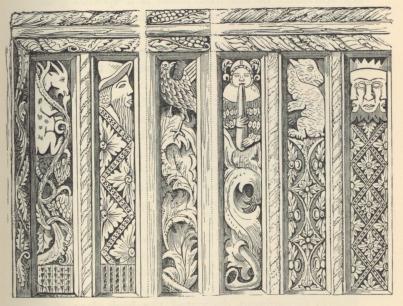The following description is lifted directly from [Blight 1885] but note that the text was prepared for the Gentleman’s Magazine 1862-64 and is largely unaltered. It must be read in the context of that date. The drawings are by the author.
SANCREED Church lies in a secluded spot among the hills about three miles westward from Penzance.
That there was a church here at the end of the thirteenth century is proved by the Taxation of Pope Nicholas IV., where it occurs as “Ecclesia Sancti Sancredi.” There are probably no existing remains of this building, except perhaps in the foundations and the lower parts of the walls of the present church, which appears to have been erected late in the fifteenth century. Its plan nearly resembles that of St. Levan—consisting of a nave and a south aisle, a south porch, a north transept, and a low tower at the west end of the nave: the walls of the tower are very massive. The font is similar to that at St. Burian; it has four angels, with crosses on their foreheads, and bearing shields. The stoup remains, and there is a niche for an image over the south door. The roodscreen has been removed, but some of its curiously-carved panels are preserved in the vestry at the north end of the transept.

Panels of Roodscreen, Sancreed.
These panels consist of two large pieces of woodwork, 8 ft. 6 in. and 8 ft. 4 in. respectively in length, the panels following in succession as they were originally placed. The carved figures are undoubtedly symbolical, though some seem more than usually grotesque. The crowned head with three faces, represented in the annexed cut, is of course intended to symbolize the Holy Trinity. The trellis-like pattern on this panel is the same as that on the Norman font at Green’s Norton, Northamptonshire (see Simpson’s Baptismal Fonts). The eagle on the third panel is very spirited. In the first panel is a spotted goat devouring the tender branches of the vine. Others contain—an owl, two-headed female figures, serpents entwined, a crowned serpent, and the pelican. These carvings were richly painted, like those of the screen at St. Burian.
The windows, with the exception of the belfry-lights, have been treated in the usual barbarous manner.
In the churchyard is a tall round-headed cross, on which is cut, among other devices, a representation of the lily of the Blessed Virgin,—a symbol very frequently used during the fifteenth century. There is another ancient cross by the west gate.
[The book continues with St. Just in Penwith. The following sketches occur later in the book.]

Pinacle, Sancreed. |

Section of Pier, Sancreed. |

Impost, Sancreed. |

Stoup, Sancreed. |